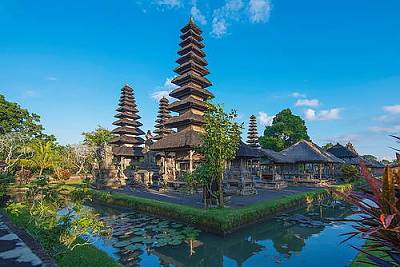- Indonesia


Water Temples of Bali, Indonesia

© Ko Hon Chiu Vincent
1. ICH domains
Social practices, rituals, festive events, knowledge and practices concerning nature and the universe
2. Short description
Water temples in Bali, Indonesia, underpin the cooperative water management system of canals and weirs known as subak, which dates from the ninth century and allows for the cultivation of rice.
Water from these canals and weirs flows through the temples and out onto the paddy fields. Water temple networks composed of farmers and others make democratic decisions on water allocation and timing of water supply. Rituals, offerings and artistic performances that aim to sustain a harmonious relationship between the natural, human, and spiritual worlds, or the ancient philosophical concept of Tri Hita Karana support their decisions.
In 2012, the Cultural Landscape of Bali Province: the Subak System as a Manifestation of the Tri Hita Karana Philosophy was inscribed on the World Heritage List (http://whc.unesco.org/en/documents/147204).
Further information:
Links describing the history and contemporary operations of water temples in Bali and its societal importance:
https://www.jstor.org/stable/677758?seq=1#page_scan_tab_contents
http://wanderingfarmers.com/farming/balinese-subak-system/
Video depicting ritual purifications and offerings in the subak landscape of Catur Angga Batukaru:
https://www.youtube.com/watch?v=1_vrw9Ejhsc
3. Link with sustainable development
In the 1970s, the Green Revolution brought new rice varieties to Indonesia, which were soon overwhelmed by pests. While subak management practices involve different communities planting different types of crops at different times of the year to best conserve water supply, pest reduction strategies implemented by agronomists in the 1970s as part of the Green Revolution required every farm to go fallow at the same time to starve the pests of food. This new government-imposed, centrally coordinated system was not successful. By reducing the role of the water temples and subaks, the delicate ecological balance was disturbed and farmers suffered. The introduction of pesticides and fertilizers during the Green Revolution also polluted the subaks, which threatened the water supply to villages. Subak practices were eventually reintroduced and environmental and farming conditions subsequently improved, attesting to the important role of water temples in allowing small-scale farmers to access clean water and share equally water resources in ways that respond to local environmental realities. For this reason, the water temples represent an important contribution to SDG 6 focused on clean water and sanitation, and SDG 2 on promoting sustainable agriculture.
4. Questions for reflection
The terraced landscapes that the water temple management systems sustain are vulnerable to social and economic threats, such as changes in (modern) agricultural practices and increasing tourism development. Farmers may not be able, or desire to, remain on their lands if tourism and infrastructural adjustments are not sustainable and responsive to the water management system and surrounding environment.
The following resources highlight challenges and current changing realities for the water temples:
https://link.springer.com/article/10.1007/s10745-010-9345-z
http://www.sciencedirect.com/science/article/pii/S0160738312000047
The integrated rice-field irrigation system in Bali also faces threats from over-tourism:
http://blog.worldagroforestry.org/index.php/2013/08/30/balis-world-heritage-rice-field-system-on-brink-of-collapse/
What specific policies might support the subak system and offset threats posed by tourism and changes in agricultural practices?